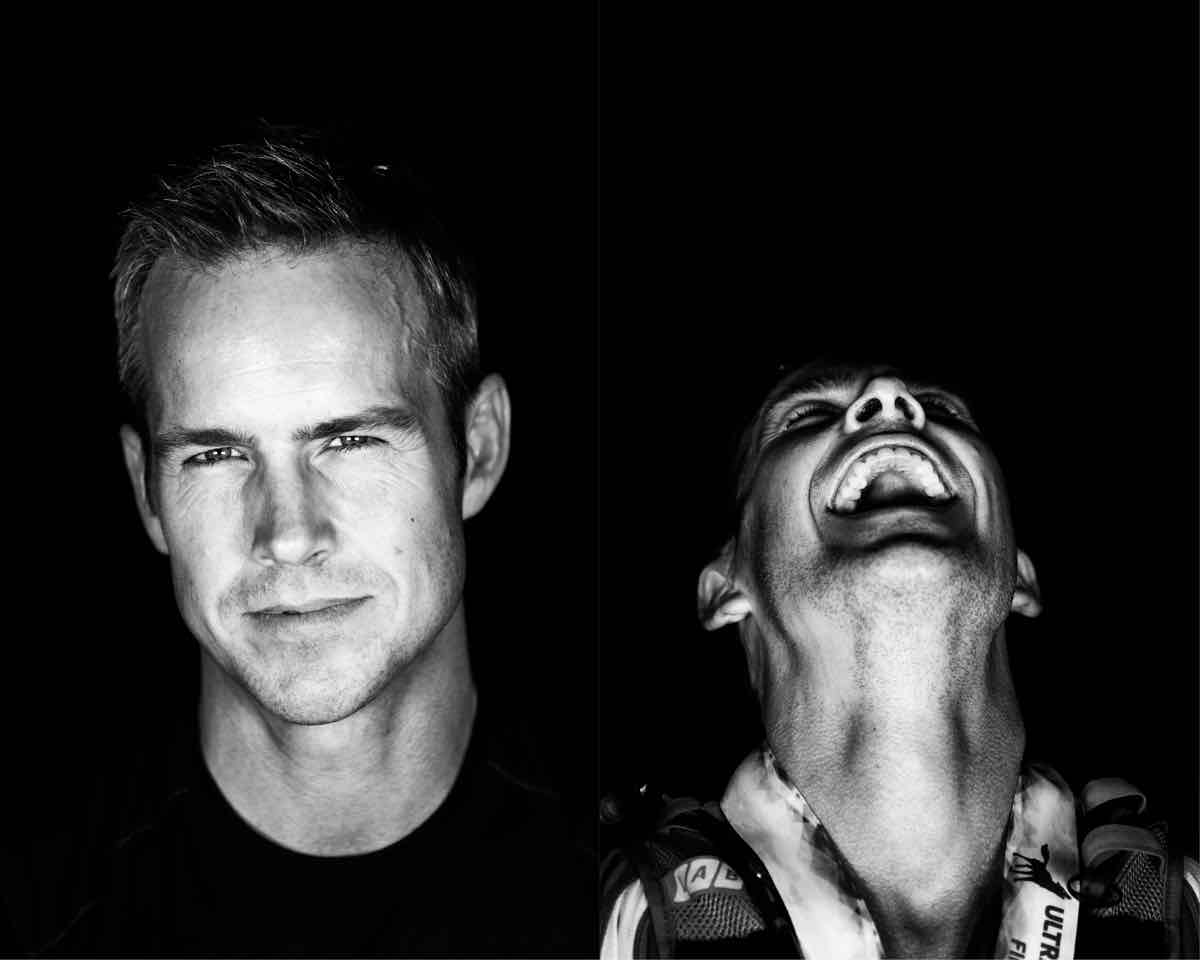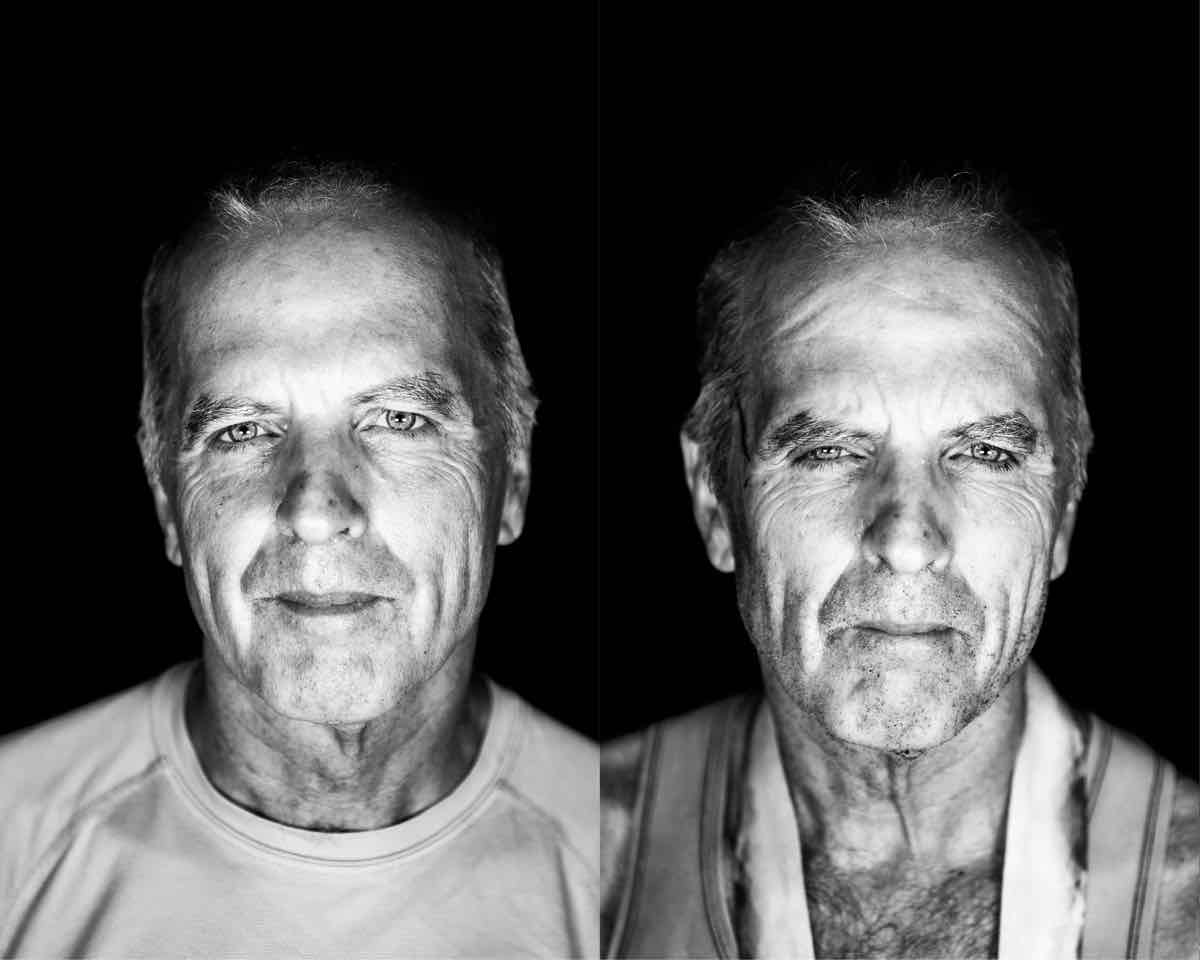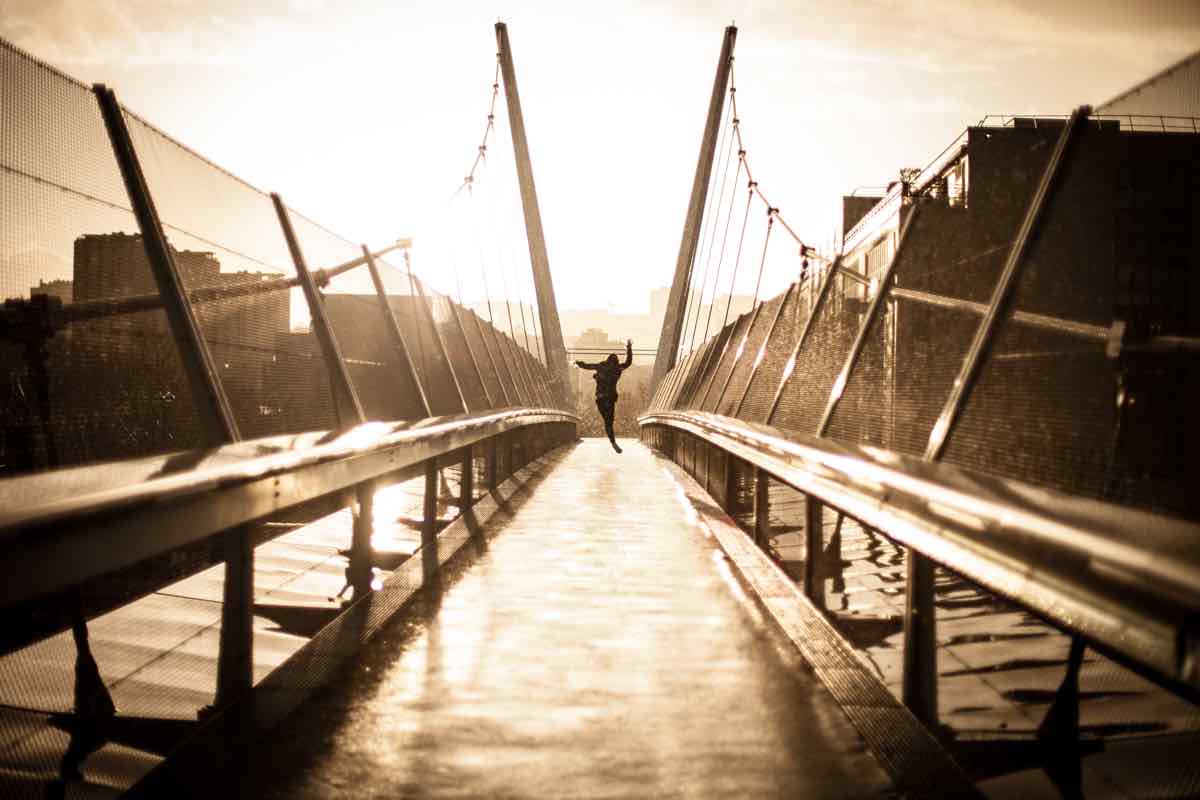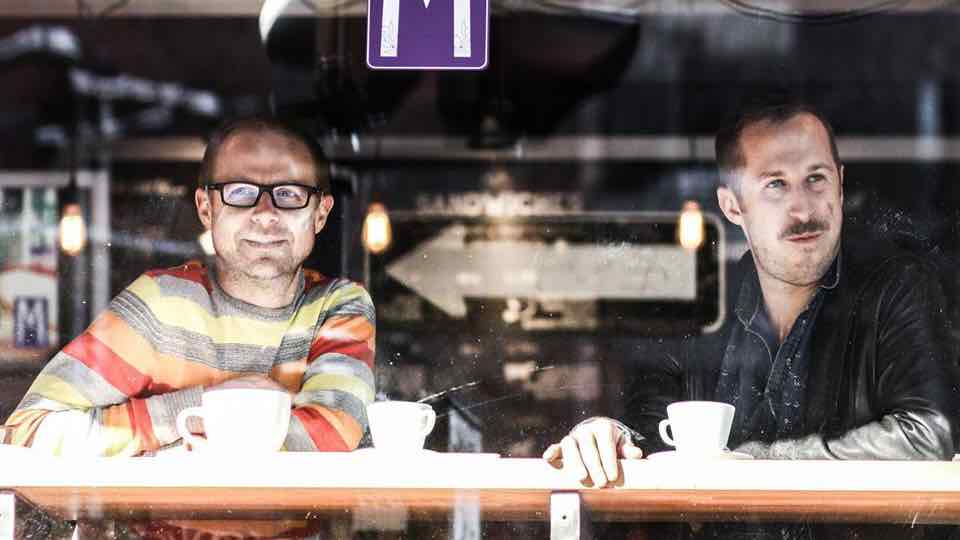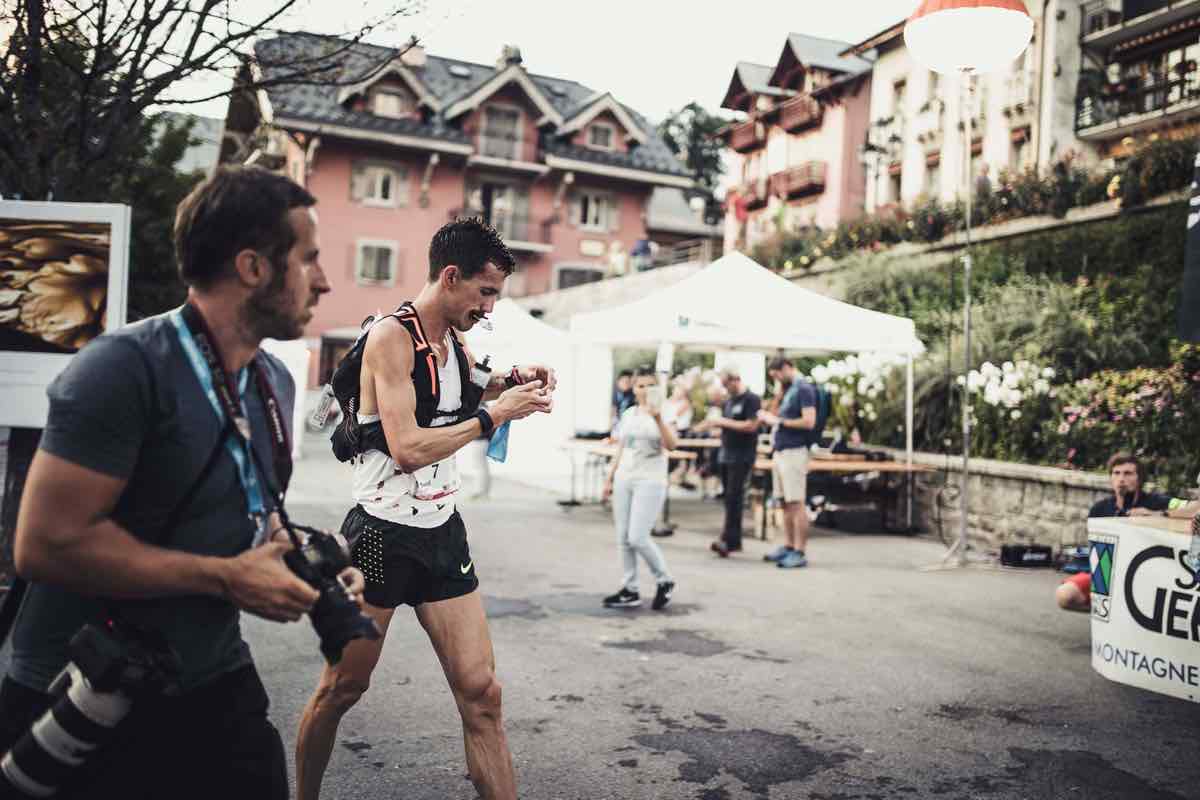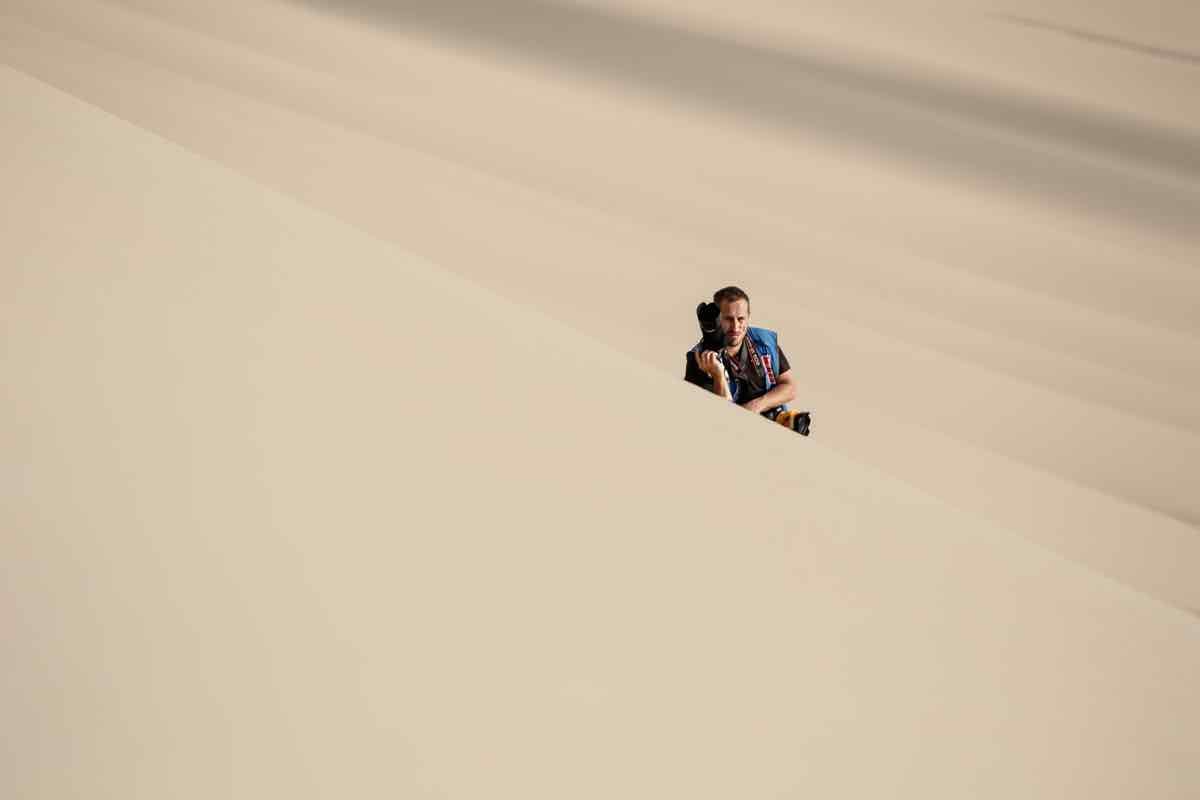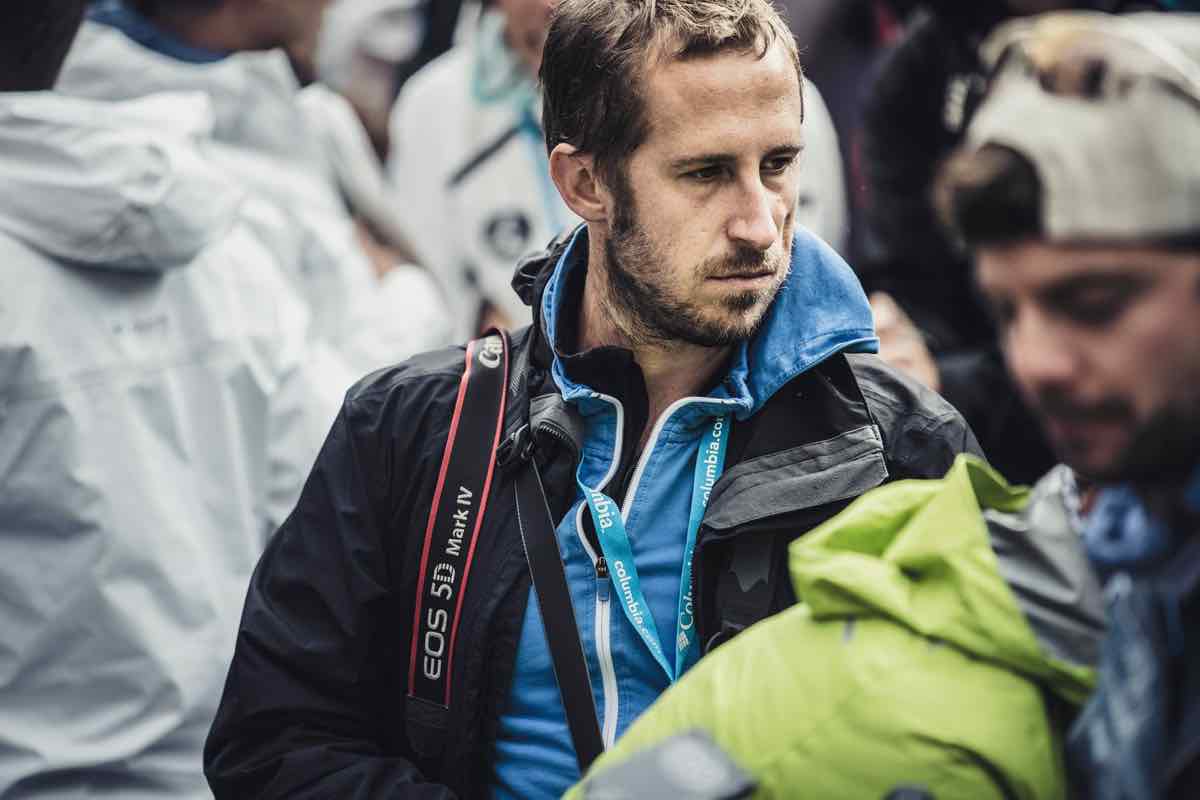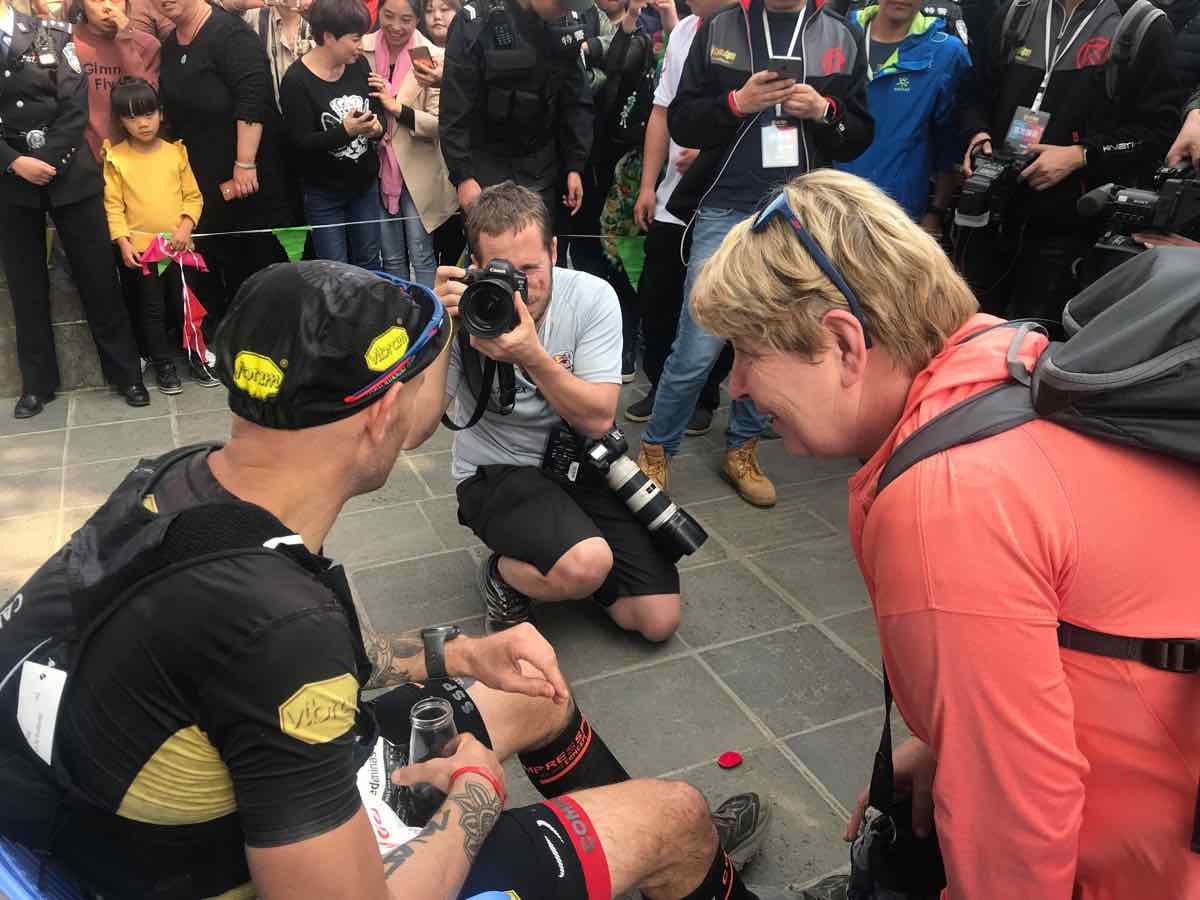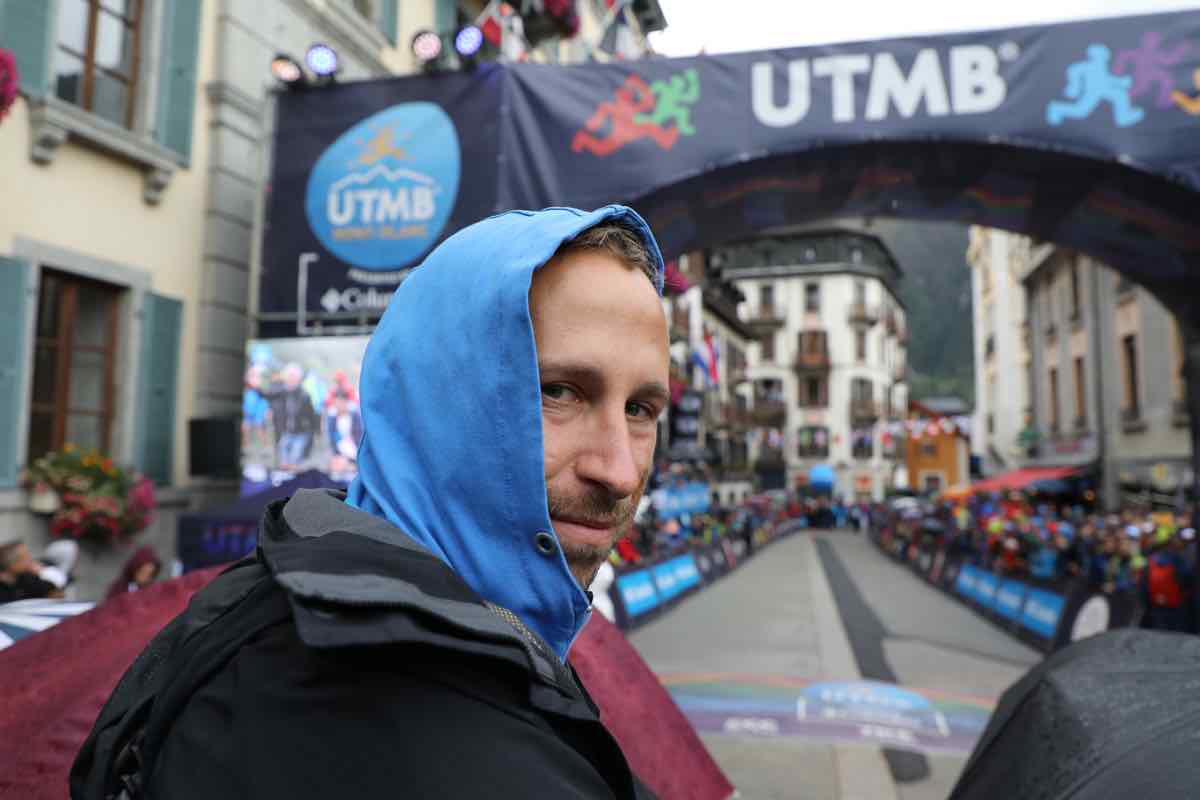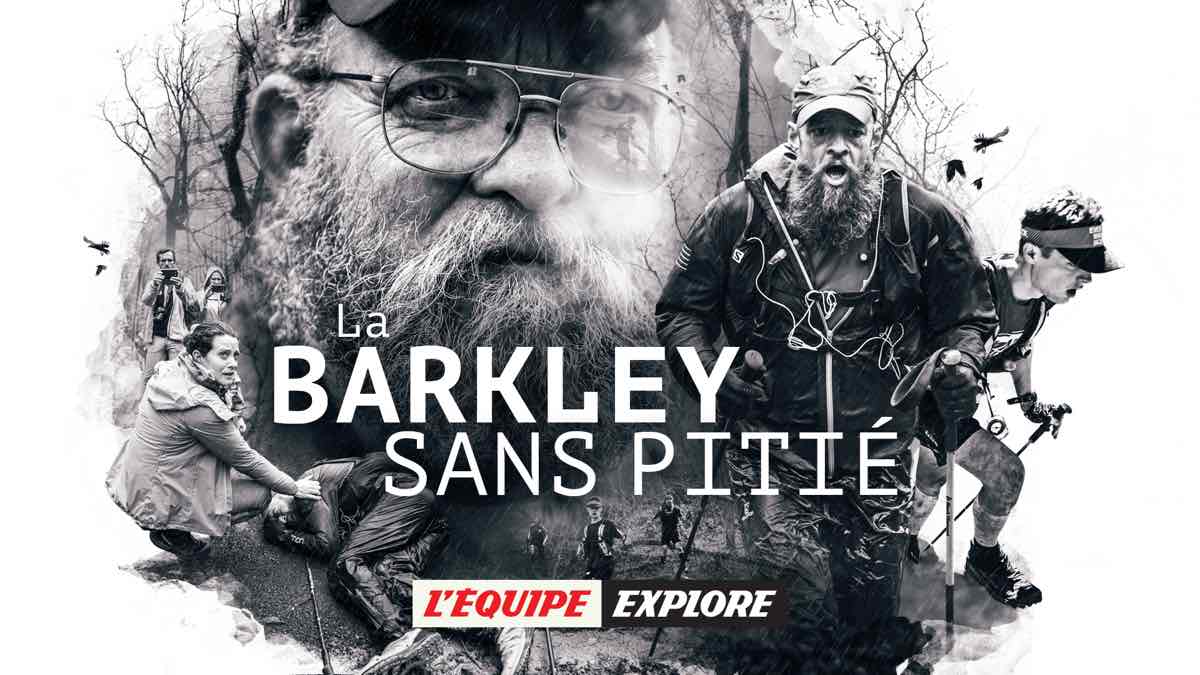Have a look at these before-and-after photographs from the 125-kilometer Ultra-Trail Harricana in Canada.
What do you see in them? What do they say? What can you hear?
These photographs are the work of French photojournalist Alexis Berg. While you may not know Alexis by name, if you are a fan of trail and ultrarunning, you have certainly seen his work. His imagery of the sport’s iconic landscapes, people, and races has a transformative power of bringing you as a viewer into the story.
Alexis grew up in Charente, Angoulême, in western France. He has two older brothers, Christophe, a vegan chef who lives in the Canary Islands of Spain and has published nearly 15 cookbooks, and Frederic, a newspaper journalist and ultrarunner–the person who introduced Alexis to our sport.
Alexis has been living in Paris, France for the last 10 years, originally drawn to the city like a magnet, he said.
“Most people go to Paris to work, but me, I was the opposite,” he said.
Alexis was a journalist in Charente, but the everyday work was too fast, too comfortable, and too predictable.
“I wanted time. I wanted freedom,” he said. “I went to Paris as if to plunge into the unknown.”
When it comes to running, Alexis prefers to run when chasing a soccer or rugby ball. He does go on solitary mountain runs every now and then.
“I think I can claim to be the person in your column who has run the least in his life,” he said, laughing. “The least far.”
Drawn to trail and ultrarunning by creative inclination, we’ll call him an ultrarunner in spirit.
Alexis was introduced to the sport after agreeing to film his brother Frederic’s Diagonale des Fous race in 2013. The day before the race, he still knew nothing of the sport.
“I made my first trail running photo in the middle of the night,” he said.
Assuming he was lost in the middle of nowhere in the darkness, Alexis said he tied his headlamp to the trunk of the tree to illuminate the trail in front of him. Crouched down, waiting for his brother to appear, two runners passed, eyeing him oddly.
Thinking that one looked too big and the other too casual to run so far, Alexis watched them pass and continued to keep a lookout for his brother. Later he learned those runners’ names were François D’Haene and Kilian Jornet.
Alexis came away from the race with many photos and videos of his brother, which grew into a 15-minute documentary about why Frederic runs ultra-trail races, which can be found on his YouTube page. Just playing around, Alexis edited some of the photos into more artistic black-and-white versions, and uploaded them onto a blog. He now has a personal website, which showcases his work.
“I still don’t know how they found these images, but a German magazine contacted me to publish them,” he said. “Then a French magazine. I was offered to photograph one race, then another, then another.”
Stumbling into the profession, Alexis says he didn’t pick up a camera until 2007.
“Something happened,” he said, when he took a hold of the device. “I quickly understood how it worked. I never took a lesson. I didn’t open books. I learned by intuition.”
Alexis said that, at the time, writing was his main focus and photos were a playful hobby and a way for him to relax.
In 2009, he was preparing to travel for a few weeks to Syria and neighboring countries. It was his first real assignment alone in an unknown area, and it was during this trip that photography became more than his hobby.
“I put a device between me and reality, to look at it, to move forward,” he explained. “Suddenly, photography made sense. I have incredible, accurate memories of this trip.”
These were his first real photos and no doubt his best, he claims.
Ever since, he has preferred a Canon as his most valuable equipment. His 5D Mark IV camera and equipment includes a wide-angle and a telephoto lens. In his shoulder bag he keeps two extra lenses with a good range of openness, which have been his routine devices on most projects. He works alongside many who worship technology, yet Alexis is not that way. He believes in the intentions, in the thoughts and plans for the resulting photograph.
“Not thinking about the brush, but thinking about what you draw,” he explained.
Alexis said being a photographer is a simple job and it needs no courage to do so.
“To make images is to look.”
Simple. Simple? It is what we are looking at that makes it difficult, though.
“There is so much to see on this planet, so many windows open, so many horizons to explore,” he said. “Light is everywhere. What is hard is to keep it.”
If you have not seen Alexis’s photos before, the best place to find stories told via his images and words is within his book, Grand Trail. The 324-page book, co-authored by Alexis and Frederic, profiles 13 world-known ultramarathons such as the UTMB, Western States 100 Mile, Hardrock 100 Mile, and Marathon des Sables. It additionally profiles 16 top trail runners. The brothers put almost a year of work into the book. [Editor’s Note: iRunFar published an excerpt from the book last summer.]
The pair began thinking about this project, hoping to create something with Frederic’s passion for the sport and Alexis’s artistic eye.
They started in January of 2015 with their destinations planned out and interviews with runners scheduled. In parallel with the book’s demands, Alexis was also the official photographer of the Ultra-Trail World Tour.
Looking back, the year was “rich in meetings,” as well as an intense traveling schedule, long days and nights, and a satisfying publishing date in November of 2016.
With the 16 athlete profiles, Alexis said it was necessary to meet each of them and spend some time together, rather than just snap photos and leave. Some of these runners include Kilian Jornet, Anton Krupicka, Emelie Forsberg, Anna Frost, Scott Jurek, Sébastien Chaigneau, and Dawa Sherpa.
“I realized with each one, a long interview was needed in order to be able to write their portraits,” he explained.
The interviews took hours and took Alexis to places either outside, in the middle of nowhere, to bars, restaurants, or national parks, which then became the most memorable aspects of the whole experience.
Sitting in a small restaurant in Boulder, Colorado, Alexis met with Krupicka. With Jornet, he grabbed some time to talk in a house in Silverton, Colorado just before Hardrock.
He remembers his interview with Jurek as the most pleasurable and memorable, since it was when Jurek was running his Appalachian Trail adventure.
“He was somewhere in Pennsylvania. I did not have an exact address,” he recalls. “It was raining, the night had fallen. I thought I would never find him.”
Giving up and about to leave, he spotted two vans on the side of the road, where he found the runner just finishing his miles for the day. He also met Jenny Jurek, Rickey Gates, and Karl Meltzer that night.
“The next day, I photographed Scott for a few hours, which is a very good memory,” he said. “Then, I headed to California to discover Western States.”
Western States is another favorite of Alexis’s.
“It illustrates the cultural strength of trail running in the United States,” he said.
Two days after a trip to Yosemite National Park in California, Alexis interviewed Ryan Sandes. Three days later it was with Gediminas Grinius on the edge of the Grand Canyon in Arizona. Then it was Joe Grant in Boulder, Colorado, and Adam Campbell and Jenn Shelton in Durango, Colorado.
When he started photographing trail running, he was faced with a brand-new sport and culture. He discovered everything in his own way, since never having studied other running photographers.
“I did not know the codes, and it was much easier to draw my own route,” he said.
Even now, he knows the sport of trail running much better, yet he continues to keep that detachment. It is that critical distance that allows him to enhance each photograph he takes with his own personal, creative touches.
For Grand Trail, there are photos specifically of the profiled athletes. But when it comes to covering a race, Alexis is nonstop moving, estimating, and shooting.
He doesn’t try or expect to capture it all. Instead, he attempts to create an image that will tell the story of one runner during one moment of a race.
Photography, he said, is like running, in that if you are not prepared, you will not go very far. The smallest of details have the biggest influence, and planning is key. The day before a race, Alexis studies the race maps in more ways than just the route directions. He is also thinking about the position of the sun and how its rays will illuminate the trail and landscape.
He explains: “The light is the raw material of the photographer. We must learn light and understand it. When I have a camera in my hand, I am constantly doing an inventory of the light and what surrounds me.”
When he is out on the trail, he is analyzing the décor, looking for the right place with the right light. Once the he finds it, and the picture is made, he moves on.
Waiting is always included in an ultra, and Alexis waits to make the stellar shot. He waits for the day to come up, for the sun to position itself between the two mountains in the background, to see if the clouds will flow over that ridge.
It is the alignment of all these uncontrollable factors that become the perfect photo.
“Some might compare this to the hunter’s expectation,” he said. “Moreover, I often hide a little to not be seen by any runners. But I am not a hunter. I do not want to kill my target; I want to give it life.”
Just like the runner, Alexis is estimating, calculating, and always counting the minutes and speeds of the world around him. He sits among the trees and mountains, waiting on the arrival of the runner.
“I like listening to the mountain until I can hear a runner before I can see them,” he said. “It is not an expectation lost in uncertainty. There is no doubt, because there is only one way: the arrival of the runner is inevitable.”
During the race, the photo will show you what is going on, especially depending on the mile marker one is at. There can be pain, joy, fatigue, or excitement to finish. For something a little different, Alexis decided to try out an idea he had of depicting the changes a runner undergoes during an ultra race. It ended up being called the before-and-after series, a mini-project he completed during the Grand Trail book year. Not a new concept, but Alexis planned to infuse into it his own artistic flare.
“I wanted to do it in very specific conditions,” he explained.
His goal was to get a picture in the seconds following the arrival of a runner at the finish of an ultra, which was difficult to organize, he said. Thanks to some really good connections with the organizers of the Ultra-Trail Hurricana in Canada, he was able to get the very clean, energized before pictures. And then, on the edge of the finish line, Alexis set up his own studio, a large black tent where runners would enter right after finishing, even before finding their support crew. It happened to be the first ultra for 80 percent of those who Alexis captured.
“They were coming to my tent and they were going to sit on a chair in this little space cut off from the world,” he said. “If the project works, it is thanks to the emotions that we can read in the eyes of the people.”
Focusing on humans as the subjects is a form of photography that Alexis enjoys the most and has been progressing in the most.
When he began to combine the human portrait with the sport of trail running, Alexis uncovered a connection much stronger and deeper than he would ever have thought. He admits that it took him many years of watching and inquiring to fully understand why it is people run.
“No, doubt among those who run (and run far), some seek to escape from this heavy time, the heaviness of our time. If they go far, if they venture ever deeper into the mountains and undergrowth unexplored, it is to tear the grip of cities, to remove the burden of everyday life, the weight of life.”
In Europe, trail running is seen as a mass sport, but from Alexis’s intimate inspection, the sport develops differently within the big cities versus the countryside and differently among social positions, class, gender, and race. In the U.S., he said, trail running sometimes portrays a counter-cultural dimension.
Taking a similar approach, Alexis does not view trail running as just a sport or his role in it just a job.
Many photographers publish dozens of photos and sell even more online–commercial photography. Though Alexis respects the job, he is not following the same rules. Even though he does produce a lot of photos, he still tries to tell a distinct story with each one.
Alexis uses other storytelling methods, too. Frederic, Alexis’s brother, wrote in a portrait a few months ago, “He writes better than he photographs.” He also slipped about Alexis’s love of good beer, good food, and that on most Tuesday nights he plays football. When his younger brother grew up, the images came, Frederic wrote. The camera became a companion, and Alexis became like a goldsmith carving rough metal into something precious.
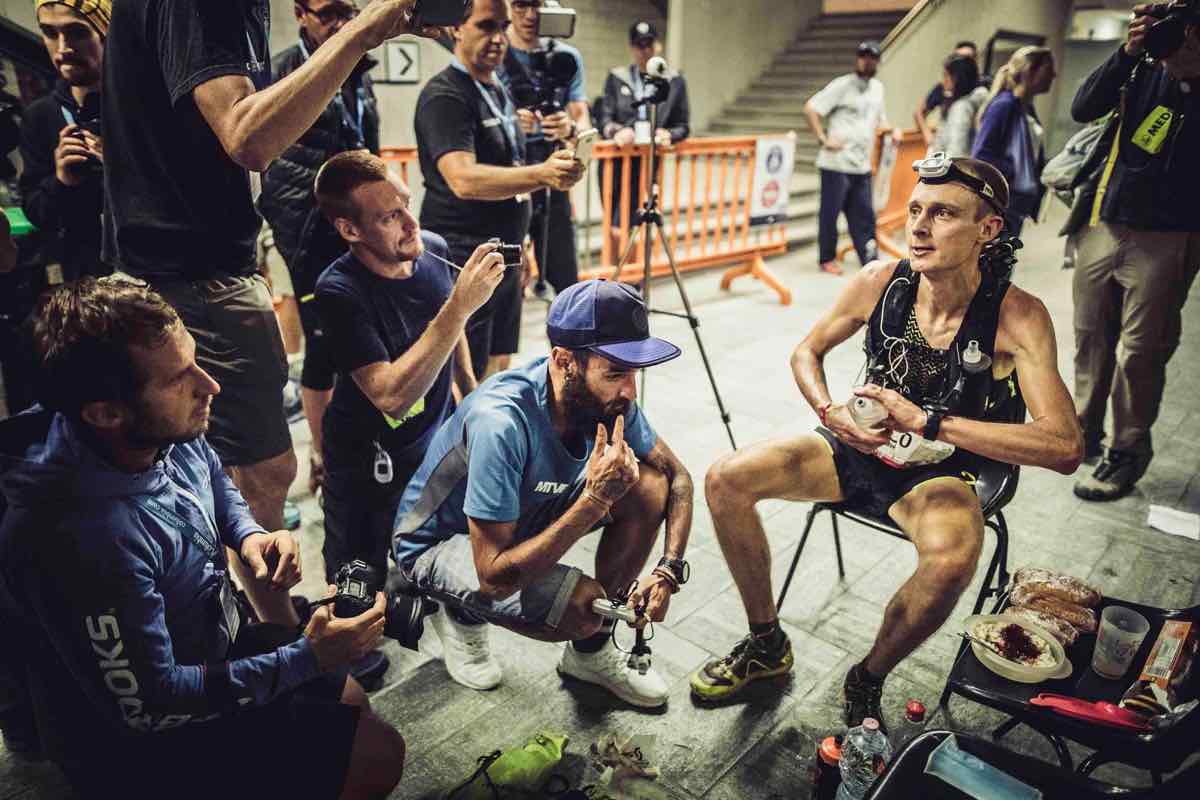
In Courmayeur, Italy during UTMB with (left to right) Alexis, Bryon Powell, Yoann Stuck, and Andy Symonds. Photo: Ugo Richard
In this short time of documenting the sport, Alexis’s images and words have appeared in many publications. To name just a few: L’Équipe magazine, MARCA newspaper, Men’s Health magazine, The Guardian newspaper, National Geographic magazine, as well as Runner’s World USA, U.K., Spain, Netherlands, and Germany magazines. He has photographs in Forever Sports magazine, Asia Trail magazine, Trail Runner magazine, Trails Endurance Mag, and Like the Wind Magazine. He has also been an official race photographer for Marathon des Sables, Badwater 135, Lavaredo Ultra Trail, Gaoligong by UTMB, Transvulcania Ultramarathon, Lofoten Ultra-Trail, among others. His website illuminates other projects as well.
His favorite project though, he decided, was his latest, a film called “La Barkley Sans Pitié.” The film was a long project depicting the story of the 2017 Barkley Marathons, what Alexis says has been his most intense running project. His photos from that event–one of which you may have seen with a distraught, exhausted Gary Robbins on the ground with his wife Linda Barton-Robbins near him after his extreme near-miss in finishing the storied event–have since been published in 20 magazines.
“The whole experience was incredible, not just the scenario, but the outcome,” he recalled. “I’m talking about the atmosphere of the race at Frozen Head State Park [in Tennessee], the special thing about the Barkley, the mystery of the race. The story was so strong that I wanted to make a movie.”
He and L’Equipe conducted interviews with Robbins, another runner John Kelly, who successfully completed the Barkley Marathons that year, and the race director Gary Cantrell aka Lazarus Lake. It was a complicated project, which ended up being a 20-minute black-and-white film made of digitally manipulated still photography, sound, and narration by the film’s subjects. Alexis says he will always keep the experience in his heart.
Thanks to this job, Alexis has traveled the world, finding new places to explore and enjoy, like drinking wine in front of the desert near the Four Corners of the U.S. or visiting the Lofoten Islands in Norway six times in several months. He wishes to visit more of South America, and even Alaska and Canada. These trips may happen this year, since with an open calendar, Alexis is planning his year based off of his own desires, and a few magazine orders. He will be on the course of UTMB this year with the Canon, and we may find a new book plan in the works soon. But that one is still a secret.
With the light of the sun and the shadows of the mountains on his side, his subjects and their emotions are captured. The aesthetic found in his photos may just be the chance of these shadows and colors, he admitted, but there is more there.
“My relationship with runners is something precious,” he said. “There are links that are created when you witness strong moments. This is one of the most memorable things in this experience: accompanying people, seeing stories evolve over several years.”
He is talking about seeing the epic finish of Gunhild Swanson at the 2015 Western States. Never forgetting the final lap of the 2017 Barkley Marathons. Last year’s Hardrock, when Kilian Jornet dislocated his shoulder and ran on, or Jim Walmsley walking back to the Western States course after missing a turn in 2016, or waiting for the helicopter after the fall of Hillary Allen in Tromsø, Norway in 2017.
“What awakens my eyes are not the images, but their depth. The stories that are released from the page.”
Call for Comments (from Meghan)
- What of Alexis Berg’s work do you especially remember?
- What stories, thoughts, and emotions do you see in Alexis Berg’s photos, words, and videos?
